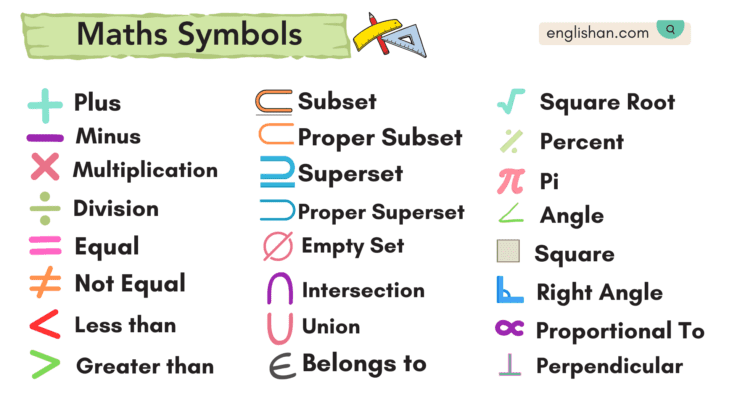Mathematics, like a puzzle, uses special symbols that unlock its secrets. We’ll explore essential Symbols of Maths with Names, like “+,” “-“, “π,” and more. These symbols help us solve tricky problems and understand math better. Learning them is like learning a secret code that works in many areas. Let’s uncover their meanings together and discover the magic of math!
List of Symbols of Maths with Name
| Symbol | Symbol Name |
| + | Plus |
| – | Minus |
| × | Multiplication |
| ÷ | Division |
| = | Equal |
| < | Less than |
| > | Greater than |
| ≤ | Less than or Equal |
| ≥ | Greater than or Equal |
| π | Pi |
| ∑ | Summation |
| ∆ | Delta |
| √ | Square Root |
| % | Percent |
| ∈ | Belongs to |
| ∞ | Infinity |
| ≠ | Not Equal |
| ° | Degree |
| ≈ | Approximately Equal |
| × | Times |
| ∠ | Angle |
| ≡ | Congruent |
| ⊥ | Perpendicular |
| ∥ | Parallel |
| ∫ | Integral |
| ∩ | Intersection |
| ∪ | Union |
| ∧ | Logical AND |
| ∨ | Logical OR |
| ~ | Tilde (Negation) |
| ∝ | Proportional To |
| ∂ | Partial Derivative |
| ∇ | Nabla (Gradient) |
| ⊆ | Subset |
| ⊂ | Proper Subset |
| ⊇ | Superset |
| ⊃ | Proper Superset |
| ∴ | Therefore |
| ∵ | Because |
| ↔ | Bidirectional Arrow |
| ⇒ | Implies |
| ∀ | For All |
| ∃ | Exists |
| ∈ | Element Of |
| ∉ | Not an Element Of |
| ⊄ | Not a Subset Of |
| ⊈ | Not a Superset Of |
| ⊅ | Not a Subset, Not Equal |
| ⊉ | Not a Superset, Not Equal |
| ⊕ | Direct Sum |
| ⊗ | Tensor Product |
| ∅ | Empty Set |
| ∆ | Change |
| ∪ | Intersection |
| ∩ | Union |
| ∖ | Set Difference |
| ∈ | Belongs to |
| ∉ | Not Belongs to |
| ⊆ | Subset |
| ⊇ | Superset |
| ⊂ | Proper Subset |
| ⊃ | Proper Superset |
| ⊄ | Not a Subset |
| ⊅ | Not a Superset |
| ⊈ | Not a Subset, Not Equal |
| ⊉ | Not a Superset, Not Equal |
| ∏ | Product |
| ∐ | Coproduct |
| ∫ | Integral |
| ∬ | Double Integral |
| ∭ | Triple Integral |
| ∮ | Contour Integral |
| ∯ | Surface Integral |
| ∰ | Volume Integral |
| ∇ | Nabla, Gradient |
| ∂ | Partial Derivative |
| ∆ | Laplace Operator |
| ∇ | Del Operator |
| ○ | Circle |
| △ | Triangle |
| □ | Square |
| ⊾ | Right Angle |
| ⊿ | Spherical Angle |
| ≺ | Precedes |
| ≻ | Succeeds |
| ≼ | Precedes or Equal |
| ≽ | Succeeds or Equal |

Maths Symbols Uses with Examples
- + (Plus): Represents addition. Used to combine quantities. Example: 5 + 3 = 8
- – (Minus): Represents subtraction. Used to find the difference between quantities. Example: 10 – 4 = 6
- × (Multiplication): Represents multiplication. Used to find the product of numbers. Example: 3 × 7 = 21
- ÷ (Division): Represents division. Used to find the quotient of numbers. Example: 12 ÷ 3 = 4
- = (Equal): Represents equality. Used to show that two expressions have the same value. Example: 2 + 2 = 4
- < (Less than): Indicates that one quantity is smaller than another. Example: 5 < 8
- > (Greater than): Indicates that one quantity is larger than another. Example: 10 > 7
- π (Pi): Represents the ratio of a circle’s circumference to its diameter. Used in geometry and trigonometry. Example: Circumference = π × Diameter
- ∑ (Summation): Represents the sum of a sequence of numbers. Used in calculus and series. Example: ∑(i=1 to 5) i = 1 + 2 + 3 + 4 + 5 = 15
- ∆ (Delta): Represents a change or difference. Used in calculus and science. Example: Δx represents the change in x.
- √ (Square Root): Represents the principal square root of a number. Used to find the value that, when multiplied by itself, gives the original number. Example: √25 = 5
- % (Percent): Represents a proportion out of 100. Used to express percentages. Example: 25% = 25/100 = 0.25
- ∈ (Belongs to): Indicates that an element belongs to a set. Example: x ∈ {1, 2, 3} means x is an element of the set {1, 2, 3}.
- ∞ (Infinity): Represents an unbounded quantity. Used in calculus and limit concepts. Example: lim(x → ∞) 1/x = 0
- ≠ (Not Equal): Indicates that two quantities are not equal. Example: 7 ≠ 10
- ° (Degree): Represents a unit of measurement for angles. Example: A right angle measures 90°.
- ≈ (Approximately Equal): Indicates that two quantities are nearly equal, but not exactly. Example: π ≈ 3.14159
- ∠ (Angle): Represents a geometric angle formed by two rays. Example: ∠ABC represents the angle at vertex B between rays BA and BC.
- ∴ (Therefore): Used to indicate a logical conclusion or implication. Example: If x = 3, and y = 2x + 1, then y = 7. ∴ y is equal to 7.
- ∵ (Because): Used to introduce the reason or cause for a statement. Example: ∵ x = 5 and y = x + 3, therefore y = 8.
- ∫ (Integral): Represents the concept of integration in calculus. Example: ∫ f(x) dx represents the integral of the function f(x) with respect to x.
- ∇ (Nabla, Gradient): Represents the gradient operator in vector calculus. Example: ∇f represents the gradient of the scalar function f.
- ∂ (Partial Derivative): Represents a partial derivative in calculus. Example: ∂f/∂x represents the partial derivative of the function f with respect to x.
- ∩ (Intersection): Represents the intersection of sets. Example: A ∩ B represents the set of elements that are in both sets A and B.
- ∪ (Union): Represents the union of sets. Example: A ∪ B represents the set of elements that are in either set A or set B.
- ∴ (Logical AND): Represents logical conjunction in propositional logic. Example: P ∧ Q is true if both propositions P and Q are true.
- ∨ (Logical OR): Represents logical disjunction in propositional logic. Example: P ∨ Q is true if at least one of the propositions P or Q is true.
- ~ (Tilde, Negation): Represents logical negation or bitwise NOT. Example: ~P is true if proposition P is false.
- ⇒ (Implies): Represents logical implication. Example: If it is raining (P), then the ground is wet (Q). P ⇒ Q.
- ∀ (For All): Represents universal quantification in logic. Example: ∀x, x > 0 means “For all x, x is greater than 0.”
You May Also Like
- Shapes Vocabulary
- Multiplication Tables From 1 to 20
- Symbol Names
- Geometric Shapes
- Determiners
- Connectors in English



